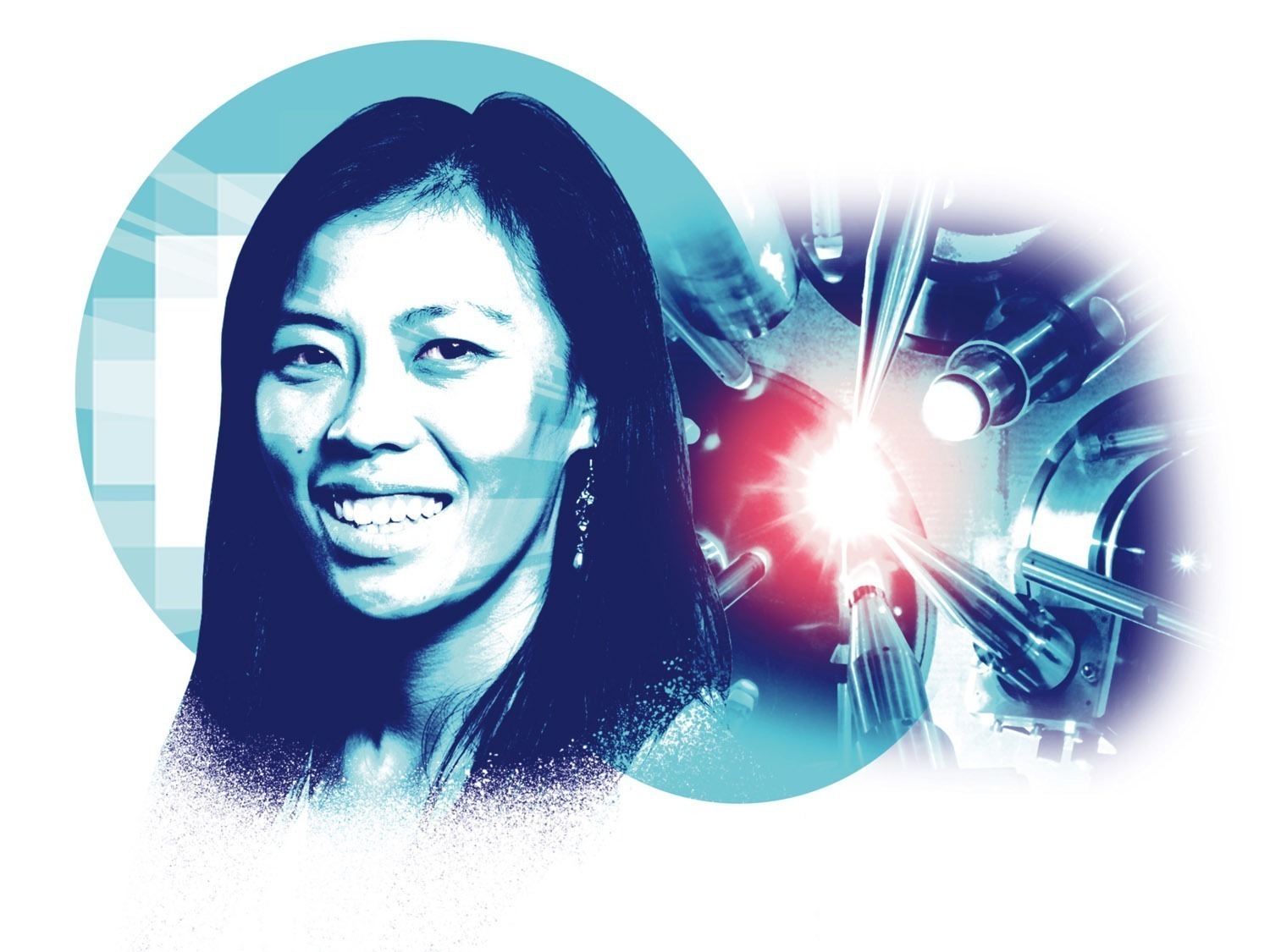The Shape of Things to Come
From better planes to blockchain, from impact investing to ethical labor, how five alumni are creating the engines that will transform our future.
by Erin Peterson

Illustrated by Mario Wagner
Caltech alumni have never been content to try to peer into the future. They want to create it. These five alumni are doing just that. From better planes to blockchain, from impact investing to ethical labor, they’re creating the engines that will transform our future.

Illustrated by Mario Wagner
Kevin Noertker has electrifying ambition
Ampaire’s co-founder wants to make the skies cleaner, quieter, and more affordable with fleets of electric airplanes.
Kevin Noertker (BS ’09) had a plum job at aerospace contractor Northrop Grumman in late 2015 when a former colleague, Cory Combs, approached him with a big idea. Would he be interested in helping found a startup that would bring electric airplanes to market?
Noertker found the idea irresistible. “I always judge an opportunity based on three criteria,” Noertker says. “Is it meaningful? Is it challenging? Is it visible?”
Combs’ idea checked every box, and in 2016, Noertker, Combs, and Ryan Bilton founded Ampaire, a company that develops electric aircraft. It’s a company that, if successful, could make an enormous impact. Compared to today’s planes, electric aircraft would eliminate tailpipe emissions entirely while slashing fuel costs by 90 percent, maintenance costs by half, and noise by two-thirds.
To pursue their admittedly expensive dream, Noertker grabbed a dirt-cheap room rental (the other two moved back with their families), scrounged free office space for the team, and worked tirelessly to drum up interest and investment capital. They’ve assembled a top-notch on-the-ground team and fleet of advisors. And they’ve carefully built, tested, and improved on their ideas to electrify aircraft within the strict confines of the highly regulated airline industry. “It’s common in software startups not to try to build something perfect upfront,” he says. “But with airplanes, you can’t just deliver them and decide to iterate when you find out that they’re falling out of the sky.”
Their smart and thoughtful work is paying off. Ampaire’s first electroprop plane is being retrofitted now, will be flying soon, and is on track for certification in 2020. The company is backed by Techstars, and Ampaire is also a portfolio company of the Los Angeles Cleantech Incubator. Last fall, Ampaire was named the top aerospace startup at the Hello Tomorrow Global Summit, an event that attracted more than 3,000 entries.
While Noertker is pleased by the accolades, he has a far larger vision in his sights. He wants to use technology to create a cleaner way to connect the world.
Tammy Ma brings laser focus to nuclear fusion
Her work at the National Ignition Facility may lead to clean and plentiful fusion energy.
In a world of imperfect energy production options—greenhouse gas-emitting fossil fuels and weather-dependent solar and wind power—nuclear fusion has long held unique promise. Unlike nuclear fission’s occasionally dangerous atom splitting, fusion’s atom-combining energy production offers a solution that is clean, safe, and limitless. The only problem? Scientists still have to crack its code. Tammy Ma (BS ’05), an experimental plasma physicist at the National Ignition Facility within the Lawrence Livermore National Laboratory, is a key member of the most powerful fusion code-breaking team on the planet.
With the help of the largest laser in the world, Ma and a team of about 100 other physicists are working to create sun-like heat and fusion through a range of nuanced experiments. “There are about 10,000 different physics parameters that we can change from experiment to experiment,” she says. “Our job is to figure out what experiments to do, do the computer simulations that pull in the data, check our models, and design the next experiment.” Ma leads and executes many of these tests.
Ma is quick to credit the work of her team, but there’s no question she’s one of its shining stars. In addition to landing a prestigious Presidential Early Career Award for Scientists and Engineers, she is also a recipient of the Department of Energy Early Career Award, an honor accompanied by $2.5 million to support her research.
Even better, Ma and the team have seen tantalizing progress in recent months. Record-breaking experiments have doubled fusion energy output from experiments conducted just a few years earlier. Fusion power is quickly moving from the lab to real life.
Ma brings a scientist’s caution to fusion-based predictions, but she is a decided optimist. “All energy technologies we’ve used have had about a 30-year cycle to adoption, but eventually it gets seeded into the grid. I am hopeful that it will happen during my lifetime.”


Kohl Gill wants a factory reset
The LaborVoices founder helps workers around the world find their strength in numbers.
Years ago, when Kohl Gill (BS ’98) was working at the State Department on a science policy fellowship linked to labor rights and corporate social responsibility, he noticed something surprising. In the busy factories of South Asia and the Middle East, thousands of people who were working in sweatshop conditions owned technology that might just be able to dismantle these inhumane organizations: their cell phones.
“I wondered if I could create a Yelp-like system where workers could tell me what’s going on in the factories,” he says. Such transparency wouldn’t just be a boon for the workers. It would also benefit companies that were committed to providing humane working conditions but couldn’t oversee the work at every factory where their goods were produced.
In that moment, the idea that now propels LaborVoices was born.
Gill and his team first put out fliers and connected with workers as they walked out of factories in India at the end of their shifts.
Now, they’ve collected tens of thousands of phone numbers of these workers across 12 countries and surveyed workers regularly, gathering deep insight about working conditions at factories around the world. Over the years, they’ve learned about unsafe spaces, abysmal pay, and suspicious after-work shenanigans. “We’ve learned, for example, that one shift might be fine, but an unauthorized overnight shift might be like a sweatshop,” Kohl says.
Today, multinational companies such as Adidas rely on LaborVoices to help them suss out what’s really going on in the factories that produce their goods—which allows them to take swift action to fix problems or change suppliers as needed.
Gill, meanwhile, dreams of an even bigger impact where workers can expect good jobs at fair pay. “My vision is a world in which every worker can find a job that moves them up out of poverty and creates great products for all of us to enjoy,” he says. “That holds a huge amount of value for everyone.”
Serena Guarnaschelli won’t grant your wish
When grant funding fails to solve big problems in the developing world, the KOIS Invest partner finds new ways to provide organizations with the money they need to make progress.
Over the course of her life, Serena Guarnaschelli (PhD ’03) has worked in refugee camps and at high-profile consulting companies, rubbed shoulders with people at the highest levels of traditional philanthropy, and buried her nose in books to earn a doctorate in behavioral finance. What she discovered was a giant funding problem that was ready to be solved. In many places, particularly in the developing world, annual grants support the work of organizations seeking to improve lives. The big mission of grant-funded organizations could be anything: treating tuberculosis, helping rehabilitate people who have lost limbs in conflict, or teaching farmers how to grow the most valuable crops on their land.
Yet grant funding often has counterproductive incentives. The annual funding makes it difficult for organizations to make long-term investments. And it may also create a cycle of dependency on grant funding, without addressing the long-term financial sustainability of the programs. While grant funding is useful to many organizations, it isn’t always the best solution. “There isn’t one financial instrument that is the best solution for everything,” Guarnaschelli says. “The solution looks more like a menu of different options.”
Guarnaschelli saw opportunity in impact investing, an exciting and fast-growing market in the financial industry. The big idea? Invest in ways that don’t just have a financial return, but a measurable social or environmental impact. The concept helps connect investors with organizations that are doing good work, using both traditional as well as innovative funding structures to help them think bigger and serve more people more effectively.
As a partner at KOIS Invest, Guarnaschelli spearheads projects that allow investors to finance innovative social solutions in markets or sectors that would otherwise not be considered investable, such as physical rehabilitation in Africa or smallholder farmers in Southeast Asia. The upfront funding may allow organizations to make long-term investments and hire and train new staff, as well as test and implement efficiency initiatives. That initial investment can lead to lower ongoing costs, better products and services, and more sustainable business practices.
Grant funding, Guarnaschelli says, will always have its place. But providing organizations in developing countries with access to investment capital to tackle complex problems has significant benefits. “To me, this opens up a world of possibilities,” says Guarnaschelli. “By deploying private capital, we can help organizations become sustainable.”

Virgil Griffith bets big on blockchain
The Ethereum research scientist and manager says those who see it as nothing more than cryptocurrency are thinking too small.
Long before Bitcoin’s grand entrance into the popular culture lexicon, Virgil Griffith (PhD ’14) was fascinated by cryptocurrency. As a graduate student in computation and neural systems at Caltech, Griffith read a captivating article by Vitalik Buterin in Bitcoin Magazine and emailed Buterin praising his ideas. Buterin noticed Griffith’s Caltech address and asked if he might crash on Griffith’s couch for a while when he was in California later that month.
At the time, Buterin had not yet made his name as the founder of blockchain platform Ethereum—he was just an eccentric 18-year-old tinkering with ideas. With some bemusement, Griffith agreed to host Buterin. After he arrived, the pair often spoke late into the night about the potential of blockchain technology.
Buterin later went on to co-found Ethereum—a distributed computing platform that makes it possible to use “smart contracts,” which are essentially self-executing agreements. Ethereum is also the company behind the cryptocurrency known as Ether. (It shares similarities with Bitcoin but has additional features as well.)
As Vitalik worked to get Ethereum off the ground, Griffith knew he could help Buterin articulate the big ideas that propelled the platform. Griffith came into the organization as a research scientist writing journal articles and has since moved into management at the company.
For now, Ethereum is used primarily as a way to send money securely worldwide without a financial institution serving to facilitate the transaction and take a cut. But because of Ethereum’s smart contracts feature, Griffith sees far larger potential. For example, Ethereum could be used for parametric insurance—when insurance payments are made not by an assessment of damage but by a triggering event. If winds in a Puerto Rican hurricane reached 100 miles an hour, for example, that might trigger an automatic and immediate payout to a homeowner, no claims adjuster needed.
Griffith also sees Ethereum as a way to expand financial opportunity—particularly to “unbank the banked.” “Everyone loathes their bank,” he says. “We are creating a future where even the banked have access to quick and cheap financial services. We’re going to take away the financial chains faced by ‘banked’ people across the world.”